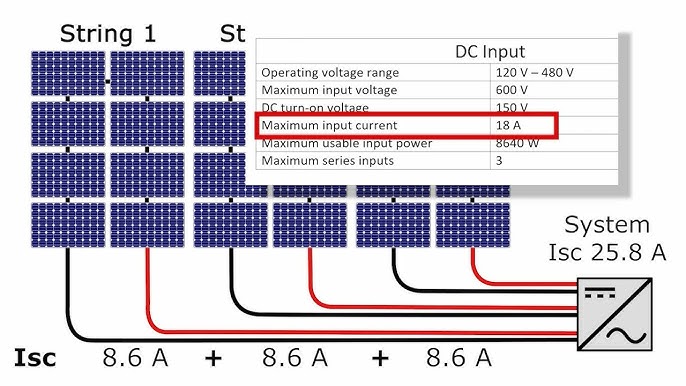Solar String sizing for the inverter | Solar Energy System Design
Welcome to the Solar Energy System Design.
This course will entail looking more closely at some of the properties of sunlight, and what happens to that light as it travels from the Sun until it eventually reaches the Earth's surface.
• Recognize differences in solar radiation for terrestrial and space applications.
• Explain variations in available solar energy.
• Use resources to determine the available isolation for a given location.
Part 1- Site identification and description
Part 2- Calculating shade losses
Part 3 -PV module and inverter selection and configuration
Part 4 - PV Watts calculation of system output under site conditions
Module Selection and Array Power
Choose a readily available polycrystalline PV module to construct your PV Array from among one manufacturer's linked below. You can choose any PV module, but include the following key specifications in your response in the text box: the company and specific model name, a link to the module specification sheet (usually pdf), along with the module's Voc, Vmp, Isc, Imp, Pmax, and voltage-based temperature coefficient (often listed as Temp. Coefficient of Voc).
Module manufacturers
• SunPower (E-series)
• Trina Solar
• LG Solar
• First Solar (4 or 6 series)
Then, calculate the number of modules required to build a system as close to the target system size you chose in part 1. Calculate the actual system power nameplate rating in kW to the nearest 0.01 based on the PV module you have selected.
Inverter Selection
Next, identify a single matching inverter (not microinverter) that meets the input and output requirements for power and energy. Choose from the available manufacturers linked below. Include the following key specifications in your response: the company and inverter model name, a link to the inverter specification sheet, the number of series inputs, V input - max, Turn-on Voltage, I input - max, P input - max, P output - max. Note that sometimes inverter specifications may be towards the end of Technical or Installation guide documents. If the selected inverter specs are located in a long document also include the page number where the spec sheet is located within the document next to the link to the document.
Inverter Manufacturers
• Fronius Primo
• SMA Sunny Boy
• SolarEdge single-phase
String sizing
Finally, determine the optimal configuration for connecting the panels of your array to the inverter. Be sure to include the number of strings connecting to the inverter, the number of modules connected together in series, and (if applicable) any parallel connections of modules or strings. For the connection(s) to the inverter, calculate the Vmp and Imp of the string as it connects to the inverter, the Isc of the string, and the cold and warm temperature voltages of concern for the string.
Make sure all your calculated connection specs will work safely with your selected inverter specifications. Always try to favor higher voltage over higher current if you have options.
Solar String sizing for the inverter | Solar Energy System Design
Welcome to the Solar Energy System Design.
This course will entail looking more closely at some of the properties of sunlight, and what happens to that light as it travels from the Sun until it eventually reaches the Earth's surface.
• Recognize differences in solar radiation for terrestrial and space applications.
• Explain variations in available solar energy.
• Use resources to determine the available isolation for a given location.
Part 1- Site identification and description
Part 2- Calculating shade losses
Part 3 -PV module and inverter selection and configuration
Part 4 - PV Watts calculation of system output under site conditions
Module Selection and Array Power
Choose a readily available polycrystalline PV module to construct your PV Array from among one manufacturer's linked below. You can choose any PV module, but include the following key specifications in your response in the text box: the company and specific model name, a link to the module specification sheet (usually pdf), along with the module's Voc, Vmp, Isc, Imp, Pmax, and voltage-based temperature coefficient (often listed as Temp. Coefficient of Voc).
Module manufacturers
• SunPower (E-series)
• Trina Solar
• LG Solar
• First Solar (4 or 6 series)
Then, calculate the number of modules required to build a system as close to the target system size you chose in part 1. Calculate the actual system power nameplate rating in kW to the nearest 0.01 based on the PV module you have selected.
Inverter Selection
Next, identify a single matching inverter (not microinverter) that meets the input and output requirements for power and energy. Choose from the available manufacturers linked below. Include the following key specifications in your response: the company and inverter model name, a link to the inverter specification sheet, the number of series inputs, V input - max, Turn-on Voltage, I input - max, P input - max, P output - max. Note that sometimes inverter specifications may be towards the end of Technical or Installation guide documents. If the selected inverter specs are located in a long document also include the page number where the spec sheet is located within the document next to the link to the document.
Inverter Manufacturers
• Fronius Primo
• SMA Sunny Boy
• SolarEdge single-phase
String sizing
Finally, determine the optimal configuration for connecting the panels of your array to the inverter. Be sure to include the number of strings connecting to the inverter, the number of modules connected together in series, and (if applicable) any parallel connections of modules or strings. For the connection(s) to the inverter, calculate the Vmp and Imp of the string as it connects to the inverter, the Isc of the string, and the cold and warm temperature voltages of concern for the string.
Make sure all your calculated connection specs will work safely with your selected inverter specifications. Always try to favor higher voltage over higher current if you have options.

























No comments:
Post a Comment